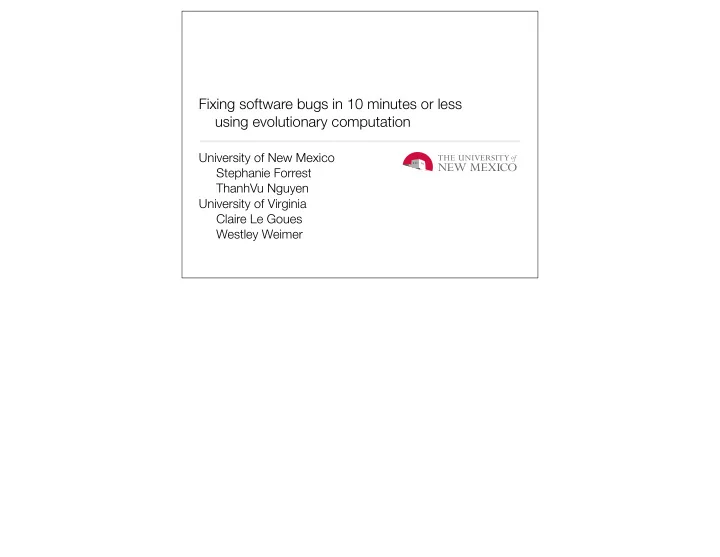

Fixing software bugs in 10 minutes or less using evolutionary computation University of New Mexico Stephanie Forrest ThanhVu Nguyen University of Virginia Claire Le Goues Westley Weimer
Summary of method • Assume: • Access to C source code • Negative test case that executes the buggy code • Positive test cases to encode required program functionality • Construct Abstract Syntax Tree (AST) • Evolve repair that avoids negative test case and passes positive test case • Minimize repair using program analysis methods
Repairing the Zune bug using GP • Infinite loop when input is void zunebug_repair(int days) { 1 last day of a leap year. int year = 1980; 2 3 while (days > 365) { 4 if (isLeapYear(year)){ if (days > 366) { 5 • Microsoft sold about 1.2 // days -= 366; // repair deletes 6 7 year += 1; million units of Zune 30, } 8 else { 9 generating thousands of 10 } complaints. 11 days -= 366; // repair inserts } else { 12 13 days -= 365; 14 year += 1; • Repair is not trivial. } 15 } 16 Microsoft’s recommendation 17 printf("current year is %d\n", year); } 18 was to let Zune drain its battery and then reset. Downloaded from http://pastie.org/349916 (Jan. 2009). • GP discovered the repair in 42 seconds.
Example repairs Program Version LOC Time to Program Description Fault Repair gcd example 22 153s handcrafted example infinite loop zune 28 42s media player infinite loop uniq ultrix 4.3 1146 34s duplicate text processing segfault ultrix 4.3 1169 45s dictionary lookup segfault look svr4.0 1.1 1363 55s dictionary lookup infinite loop look svr4.0 1.1 1504 109s metric conversion segfault units ultrix 4.3 2236 131s document processing segfault dero ff 1.9.1 9906 546s source code processing infinite loop indent flex 2.5.4a 18775 230s lexical analyzer generator segfault atris 1.0.6 21553 80s graphical tetris game loc. stack bu ff er exploit nullhttpd 0.5.0 5575 578s webserver rem. heap bu ff er exploit openldap io.c 2.3.41 6519 665s directory protocol non-overflow DOS lighthttpd fastcgi.c 1.4.17 13984 49s webserver rem. heap buf overflow php string.c 5.2.1 26044 6s scripting language int overflow wu-ftp 2.6.0 35109 2256s FTP server format string total 144933 Figure 5: Benchmark programs used in our experiments, with size in lines of code (LOC).
Why is this human competitive? • Software is THE (indisputably difficult) problem • Time to discover a repair • Quality of repair
Software is THE problem • Software faults and debugging are expensive: • US corporate development organizations spend $5.2 - $22 million annually fixing software defects (IDC Software Quality Survey, 2008) • Cost of repairing bugs increases throughout the development process. A $25 fix while the program is under development increases to $16,000 after the software has gone live (IBM Rational group, 2008) • Security violations are expensive: • Average total per-incident costs in 2008 were $6.65 million, compared to an average per-incident cost of $6.3 million in 2007. • Monetary loss by 639 companies in 2005 totaled $130 million (FBI 2005)
Software is THE problem • Bugs are plentiful: • Mozilla project received 51,154 bug reports in 2002-2006. • In 2005, a Mozilla developer reported that “almost 300 bugs appear every day that need triaging.” • Fixing bugs is time-consuming: • Industrial software repair: 1/2 of all fixed bugs in Mozilla from 2002-2006 took more than 29 days for developers to fix; Median repair time for ArgoUML project in 2002-2003 was 190 days; Median repair time per bug for PostgreSQL was 200 days.
Time to discover repair • To date, we have repaired 15 programs totaling nearly 150,000 lines of code • Average time to repair: 3 minutes (for first 11 programs shown) • Time includes: • GP algorithm (selection, mutation, calculating fitness, etc.) • Running test cases • Pretty printing and memoizing ASTs • gcc (compiling ASTs into executable code)
Quality of repair • Manual checks for repair correctness. • Microsoft requires that security-critical changes be subjected to 100,000 fuzz inputs (randomly generated structured input strings). • Used SPIKE black-box fuzzer (immunitysec.com) to generate 100,000 held- out fuzz requests for web server examples. • In no case did GP repairs introduce errors that were detected by the fuzz tests, and in every case the GP repairs defeated variant attacks based on the same exploit. • Thus, the GP repairs are not fragile memorizations of the input. • GP repairs also correctly handled all subsequent requests from indicative workload.
Why should we win the prize? • The idea of computational evolution (genetic algorithms) was introduced nearly 50 years ago (by JHH). • Led to many successes in engineering and science. • Yet, the dream of “automatic programming” is still largely unfilled. • Why does the evolutionary approach to design work throughout nature and engineering, but not in software? • A gap in the evolutionary record that needs to be filled.
Recommend
More recommend